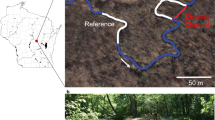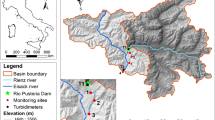Abstract
The Nueces River is the primary source of freshwater inflow to Corpus Christi Bay and virtually the only source of freshwater inflow in the Nueces Delta. In association with reservoir development and operation within the Nueces Basin, the magnitude of freshwater inflow has been greatly reduced since 1958. Continually increasing salt concentrations in the soil and water have compromised the function of the delta as a viable component of the estuarine ecosystem. In 1993, the U.S. Bureau of Reclamation began a 5-yr diversion project to increase the opportunity for freshwater flow into the delta. With the excavation of two overflow channels, the minimum flooding threshold for the upper delta was significantly lowered, and more frequent diversions of freshwater from the Nuecess River were enabled. During the 50-mo diversion period, the amount of freshwater diverted into the upper Nueces Delta was increased sevenfold. The average salinity gradient in the upper delta reverted to a more natural pattern, with average salinity concentrations decreasing from the lower (bay) to upper (riverine) delta, and a corresponding improvement in abundance and diversity of both intertidal vegetation and benthic communities.
Similar content being viewed by others
Literature Cited
Alexander, H. D. andK. H. Dunton. 2002. Freshwater inundation effects on the emergent vegetation of a hypersaline salt marsh.Estuaries 25:1426–1435.
Almonte, J. N. 1835. Statistical report on Texas. C. E. Castañeda (trans.), 1925The Southwestern Historical Quarterly 28:177–222.
Armstrong, N. E.. 1982. Responses of Texas estuaries to freshwater inflows, p. 103–120.In V. Kennedy (ed.), Estuarine Comparisons. Academic Press, New York.
Asquith, W. H., J. G. Mosier, andP. W. Bush. 1997. Status, trends and changes in freshwater inflows to bay systems in the Corpus Christi Bay National Estuary Program Study Area. CCBNEP-17. Coastal Bend Bays and Estuaries Program, Corpus Christi, Texas.
Bureau of Reclamation. 2000a. Concluding Report: Rincon Bayou Demonstration Project. U. S. Department of the Interior, Bureau of Reclamation, Austin, Texas.
Bureau of Reclamation. 2000b. Analysis of the historic flow regime of the Nueces River into the upper Nueces Delta, and of the potential restoration value of the Rincon Bayou Demonstration Project. Appendix C Concluding Report: Rincon Bayou Demonstration Project. U. S. Department of the Interior, Bureau of Reclamation, Austin, Texas.
Bureau of Reclamation. 2000c. Recent trends in precipitation occurring on the Nueces River watershed of South Texas. Appendix D, Concluding Report: Rincon Bayou Demonstration Project. U. S. Department of the Interior, Bureau of Reclamation. Auston, Texas.
Bureau of Reclamation 2000d. Hydraulic Analysis of Rincon Bayou Using HEC-2, Rincon Bayou-Nueces Marsh Wetlands Restoration and Enhancement Project. U. S. Department of Interior, Bureau of Reclamation, Great Plains Regional Office. Billings, Montana.
Collier, A. andJ. Hedgpeth. 1950. An introduction to the hydrography of tidal waters in Texas.Publications of the Institute of Marine Science 1:125–194.
Scopeland, B. J.. 1966. Effects of decreased river flow on estuarine ecology.Journal of Water Pollution Control Feleration 38:1831–1839.
Daiber, F. C.. 1986. Conservation of Tidal Marshes. Van Nostrand Reinhold Co., New York.
Grover, N. andA. Harrington. 1943. Streamflow: Measurement, Records and Their Uses. John Wiley and Sons, New York.
Hollon, W. E. (Ed.). 1956. William Bollaert's Texas. University of Oklahoma Press. Norman, Oklahoma.
Howell, C. W. 1879. Survey of Aransas Pass and Bay up to Rockport and Corpus Christi, Texas and Corpus Christi Pass and Channel. Appendix K, Annual Report, Chief of Engineers. U.S. House of Representatives, 46th Congress, 2nd Session. U. S. Government Printing Office, Washington, D.C..
Ketchum, B. H.. 1951. The exchange of fresh and salt water in tidal estuaries.Journal of Marine Science Research 10:18–38.
Montagna, P. A. andR. D. Kalke. 1992 The effect of freshwater inflow on meiofaunal and macrofaunal populations in the Guadalupe and Nueces estuaries, Texas.Estuaries 15:307–326.
Montagna, P. A., R. D. Kalke andC. Ritter. 2002. Effect of restored freshwater inflow on macrofauna and meiofauna in upper Rincon Bayou, Texas, USA.Estuaries 25:1436–1447.
Montagna, P. A., J. Li andG. T. Street. 1996. A conceptual ecosystem model of the Corpus Christi Bay National Estuary Program Study Area. Report CCBNEP-08. Texas Natural Resource Conservation Commission, Austin, Texas.
Nixon, S. W.. 1980. Between coastal marshes and coastal waters: A review of twenty years of speculation and research on the role of salt marshes in estuarine productivity and water chemistry. p. 437–525.In P. Hamilton and K. MacDonald (eds.), Estuarine and Wetland Processes with Emphasis on Modeling. Plenum Press, New York.
Odum, E. P.. 1961. The role of tidal marshes in estuarine production.New York State Conservation 16:12–15.
Palmer, T., P. Montagna andR. Kalke. 2002. Downstream effects of restored freshwater inflow to Rincon Bayou, Nueces Delta, Texas, USA.Estuaries 25:1448–1456.
Peirce, A. C. 1894. A Man from Corpus Christi, or the Advantures of Two Bird Hunters and a Dog in Texan Bogs. Forest and Stream Publishing Company. New York.
Pritchard, D. W.. 1967. What is an estuary: physical viewpoint, p. 3–5.In G. Lauff (ed.), Estuaries. Publication No. 83. American Association for the Advancement of Science, Washington, D. C.
Ward, G. H.. 1985. Evaluation of marsh enhancement by freshwater diversion.Journal of Water Resources Planning and Management, ASCE 111:1–23.
Ward, G. andC. Montague. 1996. Estuaries, p. 12–1-12–114.In L. Mays (ed.), Water Resources Handbook. McGraw-Hill Book Company, New York.
Ward, G. H.. 1997. Processes and trends of circulation within the Corpus Christi Bay National Estuary Program Study Area. Report CCBNEP-21. Corpus Christi Bay National Estuary Program, Corpus Christi, Texas.
Author information
Authors and Affiliations
Corresponding author
Rights and permissions
About this article
Cite this article
Ward, G.H., Irlbeck, M.J. & Montagna, P.A. Experimental river diversion for marsh enhancement. Estuaries 25, 1416–1425 (2002). https://doi.org/10.1007/BF02692235
Received:
Accepted:
Issue Date:
DOI: https://doi.org/10.1007/BF02692235




